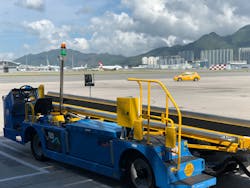Many commercial airlines and ground handlers continue to use spreadsheets to manage expensive assets critical to their operations. Or, as Santosh Nachu, general manager of EBIS software at Tronair, describes them, “inadequately built homegrown solutions that can no longer handle the scale and complexity of their present-day reality.”
It’s surprising, Nachu says.
Although asset management technology is not new, Matthias Moulinier, product director for ADVEEZ, says it is not something that has been widely deployed – at least not yet.
“We were seeing a big push just before COVID,” he says, noting implementation of the technology was the delayed by the pandemic.
In the past couple of months or so, however, he says requests for the technology have been increasing.
“There is still a lot of airline, ground handling company that needs a system to understand how their fleet are used and how they can improve safety around aircraft by using telematics and making sure they have the right equipment at the right place at the right time,” Moulinier says.
If a ground service provider doesn’t have an asset management system in place, Nachu suggests starting by creating an accurate and comprehensive repository of assets and initiating preventative maintenance (PM) procedures and schedules. Another option, according to Nachu, could be streamlining parts procurement with real-time integrations and understanding part component usage with telemetry to optimize parts spending.
“We pride ourselves in our ability to help collect accurate data from various stakeholders and sources that are unique to ground handling,” Nachu says. “However, it is our domain expertise and focus within this niche that helps us contextualize and analyze this data to guide our customers with the right remedies for what ails them.”
When EBIS was selected by a U.S. ground handler in 2020, Paul Schwarzbaum, Tronair’s president and CEO, was quoted saying that with an ROI of up to 17X, EBIS 5.0 enables customers to fully capture cost savings and productivity benefits.
“Customers are at various levels of maturity in their asset management journeys,” Nachu says. “In almost all cases, the performance maturity can be different from location to location within the same organization. Therefore, the ROI is also a direct function of how much room for improvement a customer has. Our holistic approach can yield these multiples, and in some cases beyond, as improvement in one area reinforces improvement in adjacent areas thus making the returns exponential.”
Workforce productivity gains are often touted as a source of savings when compared to more manual work order management processes. However, Nachu says if PM schedules can be adjusted to match the asset and its usage, the most frequent failure modes or components can be identified and designed out during subsequent PMs. Then workforce productivity gains are not just linear, but exponential. More scheduled PMs and better components could lead to fewer failures and result in less rework and unscheduled repairs.
“The 17X ROI was a result of this holistic approach,” Nachu says. “It was achieved through a combination of reducing inventory carrying costs, better warranty cost recovery, workforce productivity gains, and equipment failure reduction. Each of these areas build upon each other and are greater than the individual sum of their parts.”
Looking to the future, there may be some smaller ground service providers who don’t use the technology, but according to David Read, general manager at Resonate MP4, “the large operators will have it as standard, because data is the only way they can accurately report their performance and demonstrate ways in which they can be held to account.”
Budget airlines, for example, turn around their planes in a very tight timeframe, Read points out.
“There’s always a bit of a question mark about if the plane is 5 minutes late – where is the source of that delay,” he says. “Without something like XOPS, you have to rely on what did a certain person say and what reports may or may not exist and what proof you may or may not have."
XOPS is a three-level modular platform (fleet, operations and data management systems) designed for the challenges of the airport and focused on delivering improvements in airside operations safety, performance, efficiency and sustainability.
"With something like XOPS, you can see it in real time and perform a full audit," Read says. "You can tell when a plane arrived, when the fueling arrived, when the baggage arrived, when it (the turnaround) was finished. It’s all there and time-stamped, which enables ground handlers to support the budget airlines in these aggressive contracts to say, I did my bit, here’s the evidence.”
While legacy systems may have basic GPS monitoring, Read says the monitoring may not be accurate to the level of less than 1 meter, and may not have many of the sensor and software features that enable rich data to be captured. Examples of the rich data that XOPS is able to capture and display in real-time include the vehicle engine management system data (battery levels, fuel consumption, etc.) as well as full behavioral analysis of both driver and vehicle.
For XOPS customers, Read says the first and most basic requirement or application is the fleet management system (FMS). This gives a customer real-time visibility to its fleet location by vehicle and a range of key metrics and reports relative to vehicle movement, use and performance.
However, he says the starting point for customers varies.
“Many know what they want to achieve from adopting XOPS, so will start with the complete solution that can optimize the whole ground handling operation,” he says. “This will include the FMS application but also the Operations Management System (OMS).”
If a ground service provider doesn’t know where to start, Read encourages them to ask for help and identify key business goals.
“These goals could range from reducing the number of vehicles on site, saving cost and reducing emissions, to optimizing how vehicles and their drivers are (automatically) scheduled every day to ensure all flights are turned around according to SLA [service licensing agreements], on time with least cost,” Read says.
To be successful, the software must integrate into a specific business.
“If it is just sits separately, then you know you don’t get the full value,” Read says. An element of trust gets built that whoever is providing the software also knows how to integrate into your business.”
Other key goals he says might include reducing journey distances or task completion times, sharing assets amongst ground handlers (pooling); monitoring the need to refuel/recharge vehicles; and eliminating dependency on human milestone reporting.
Moulinier says one of the common questions he’s frequently asked is if the system is difficult to implement on GSE. Ground service providers know that GSE is very specific. Cars and trucks have a dedicated plug, but that’s not the case with GSE.
“Customers want to make sure they are investing in a system that can cover every brand and model and type (diesel, gasoline, electrical, hydrogen, 12V, 80V). They want a system that covers everything,” he says.
Customers also ask about the user interface.
“They want to have access to the platform anywhere in the world,” Moulinier says, adding they want a platform that can be used with any new GSE unit coming into the market.
By knowing how each piece of equipment is used and having the data in hand, he says ground service providers can know if they need more or less equipment. In reality, Moulinier explains, 95 percent of ADVEEZ customers have too much equipment and company officials can see this very quickly. When that’s the case, GSE can be moved to another airport.
Customers are also looking for asset management technology for non-motorized equipment, which is a relatively recent advancement.
More advanced applications include integrated vehicle CCTV for enhanced incident management. Read says the use of CCTV to report/reduce incidents has a positive impact on health and safety and can reduce both repair and insurance costs.
Specialized applications focus on cargo, baggage, passenger ground transportation, aircraft fueling and asset pooling, to name a few, says Read.
“Our aim is to respond to customer needs, but also lead the future,” Read says. “Today there is much focus on integrated in-vehicle CCTV giving the operations controller instant access to incident data via one application (XOPS), as well as rich data from the engine management systems/CANbus across all suppliers of GSE. XOPS is one of the leading integrators so that rich data is displayed in real-time in one application regardless of vehicle type/make.”
Safety is always top of mind, Read says. In support of this, he says XOPS now offers XOPS Speed Assist to automatically and safely reduce the speed of a vehicle to the applicable limit in any zone in an airport environment, such as baggage halls, aircraft stands, etc.
“Many talk of the ‘dark apron’ when automated driverless vehicles will perform the necessary tasks,” he says. “XOPS is working with GSE suppliers to provide the telemetry solutions that enable these driverless vehicles to work more efficiently in the confines of an airside environment.
“Having the ability to supply the technology today is one thing. Being able to continue to evolve your solution to meet the advancing needs of the ground handlers, the airlines and even the suppliers of the GSE is a critical part of it. That’s an important part of our investment plan and what we do is keeping up with the future requirements of our customers.”
About the Author
Rebecca Kanable
Assistant Editor
Rebecca Kanable, a veteran journalist, worked with Endeavor Business Media's aviation group from 2021 to 2024 as assistant editor of Airport Business, AMT and Ground Support Worldwide. She previously worked for various publications, including trade magazines and newspapers.

